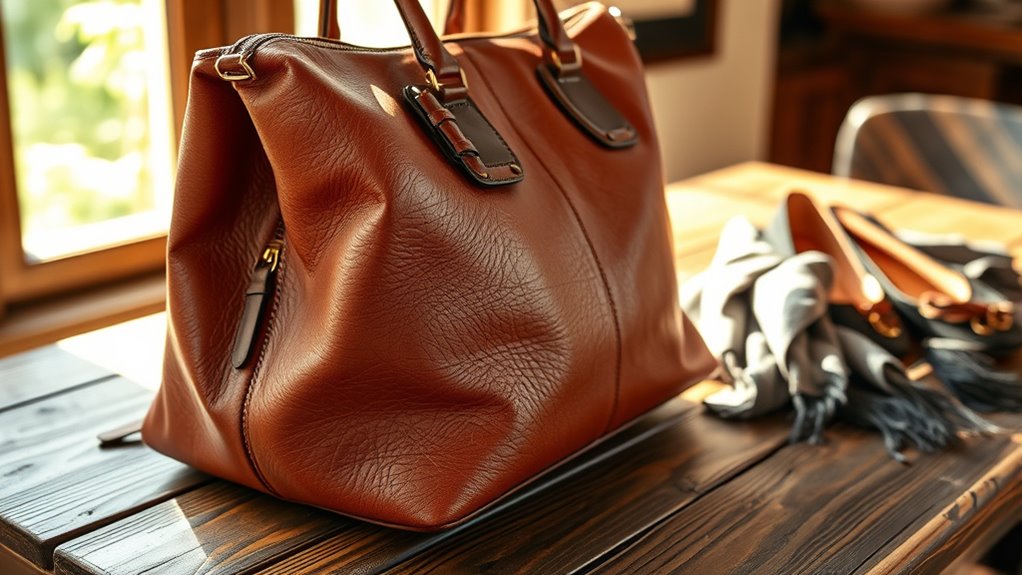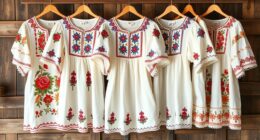Before splurging on a piece, consider its cost per wear by dividing the price by how often you expect to use it. This helps you determine if the investment is worthwhile, encouraging you to opt for quality items that last longer and fit your lifestyle. Focusing on versatility and durability guarantees your wardrobe remains stylish and cost-effective. If you want to master this strategy, you’ll discover more tips on making smarter fashion decisions.
Key Takeaways
- Calculate cost per wear by dividing the item’s price by how many times you expect to wear it.
- Prioritize investing in quality, versatile pieces that can be worn frequently to lower the cost per wear.
- Use the concept to assess if a splurge is justified based on how often you’ll wear the item.
- Tracking actual usage helps determine if an item is a worthwhile long-term investment.
- Applying cost per wear encourages thoughtful shopping, promoting sustainability and a cohesive wardrobe.

When you’re trying to make smarter shopping choices, understanding “cost per wear” can be a game-changer. It’s a simple yet powerful way to evaluate whether a fashion investment is truly worth it. Instead of focusing solely on the price tag, you consider how often you’ll actually wear an item over its lifespan. This approach helps you avoid impulsive purchases and encourages you to think more strategically about your wardrobe. By calculating cost per wear, you can make more informed decisions that enhance your wardrobe longevity and overall style.
Think of it as a way to maximize the value of every dollar spent on clothing. For example, a designer jacket might seem expensive upfront, but if you wear it weekly for years, the cost per wear drops considerably. Conversely, a cheaper piece that only gets worn a few times isn’t really saving you money in the long run. This perspective shifts your focus from price alone to the item’s utility and durability. It encourages you to seek quality pieces that stand the test of time, making your wardrobe more cohesive and sustainable.
Maximize clothing value by considering durability and frequency of wear over price alone.
Understanding cost per wear also aligns with the idea of a fashion investment. When you view certain items—like a classic blazer, a versatile pair of shoes, or a well-made handbag—as investments, you’re more likely to prioritize quality over quantity. These pieces tend to have greater wardrobe longevity, meaning they stay stylish and functional longer, offering more bang for your buck. By estimating how often you’ll wear these items, you can better gauge whether they’re worth splurging on or if you should opt for more affordable alternatives.
Calculating cost per wear is straightforward. You divide the price of the item by the number of times you expect to wear it. For example, if a $200 coat is worn 50 times, its cost per wear is just $4. That’s a much better deal than a $50 scarf worn twice, which costs $25 per wear. Keeping track of your wardrobe’s usage can help you identify which pieces are truly worth the investment and which ones aren’t. Additionally, understanding creative practice can inspire you to develop a more thoughtful approach to wardrobe planning and styling. Over time, this practice encourages smarter shopping habits, reducing clutter and ensuring your wardrobe lasts longer.
Ultimately, understanding cost per wear transforms how you view shopping and wardrobe building. It shifts your mindset from fleeting trends and quick fixes to thoughtful, sustainable choices. By focusing on quality, durability, and how often you’ll wear your clothes, you ensure your wardrobe remains versatile, stylish, and financially sound. This way, every purchase becomes a strategic move toward a more refined, long-lasting wardrobe investment.
Frequently Asked Questions
How Do I Track My Clothing Usage Accurately?
To track your clothing usage accurately, start with wear tracking by noting each time you wear an item. Use a journal, app, or calendar to log your outfits daily, focusing on how often you wear specific pieces. This helps you measure usage effectively, revealing which clothes get the most wear. Consistent wear tracking ensures you’re making informed decisions about your wardrobe, so you avoid unnecessary splurges and maximize your clothing’s value.
Does “Cost per Wear” Apply to Accessories and Shoes?
You bet “cost per wear” applies to accessories and shoes, too. Think of accessory valuation and shoe longevity as your tools for smarter splurging. When you track how often you wear them, you’ll see their true worth over time. It’s like hitting two birds with one stone: you get more bang for your buck and make better purchasing decisions. So, don’t overlook these items—they’re worth the investment!
How Does Seasonality Affect the Calculation?
Seasonality impacts your cost per wear because seasonal fluctuations influence how often you wear an item. If you rotate your wardrobe frequently to match seasons, your shoes and accessories might get less use during off-season months, raising the cost per wear. To get a true picture, consider how often you wear an item throughout the year and adjust your wardrobe rotation accordingly, ensuring you calculate a realistic cost per wear.
Can “Cost per Wear” Help Reduce Overall Wardrobe Expenses?
Think of “cost per wear” as your personal financial compass, guiding your wardrobe budgeting. It helps you see beyond luxury investments’ initial price, revealing their true value over time. By focusing on how often you wear each piece, you can cut unnecessary expenses and make smarter splurges. Yes, it can help you save money, ensuring your wardrobe stays stylish without draining your wallet, just like a savvy shopper in a bustling marketplace.
What if I Wear an Item Only for Special Occasions?
If you wear an item only for special occasions, it can still be a good investment if it adds to your wardrobe versatility. Think about how often you attend such events and whether the piece will be useful multiple times or just once. Even for special occasion wear, considering the cost per wear helps you decide if it’s worth splurging, ensuring your wardrobe remains functional and budget-friendly.
Conclusion
Next time you’re eyeing that pricey jacket, picture it hanging in your closet, catching sunlight and memories as you wear it through seasons. When you calculate the cost per wear, you’re weaving stories into the fabric, turning a splurge into an investment. So, before you make that purchase, envision yourself confidently styling it, knowing each wear adds value. This mindset transforms shopping from a gamble into a mindful choice, making every dollar feel like a step toward something lasting.










